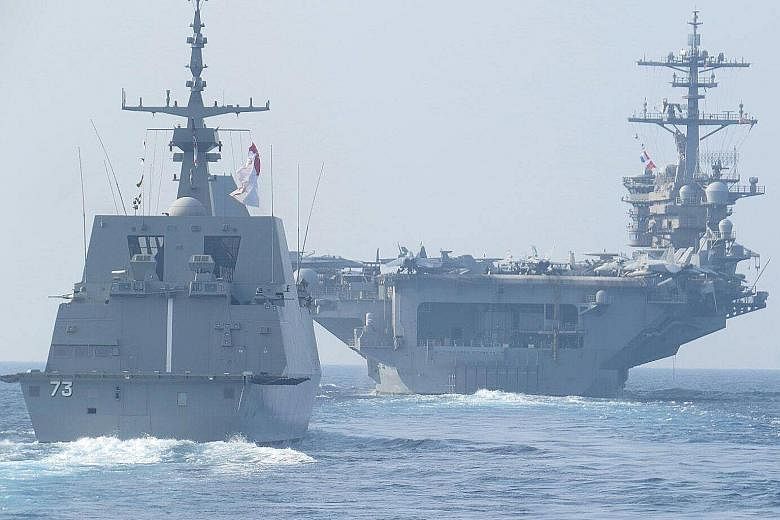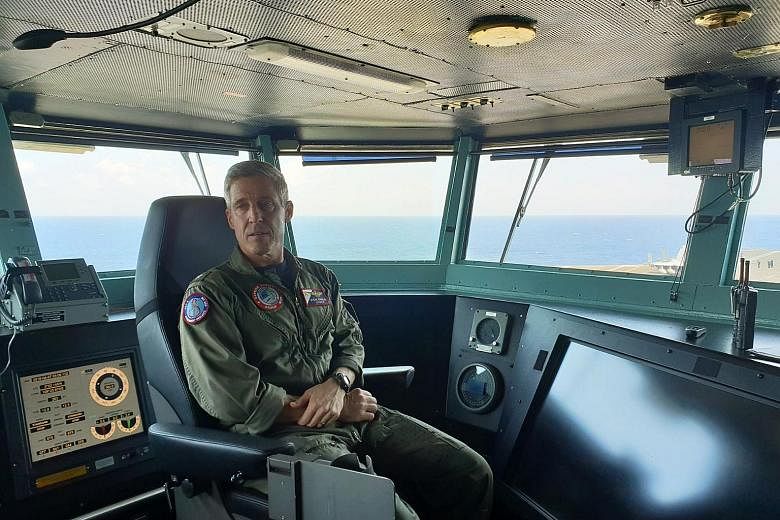It is important for the United States Navy to maintain its presence in the Asia-Pacific region to send a message that the "maritime commons" are open for free trade, the commander of Carrier Strike Group 9, Rear-Admiral Steve Koehler, has said.
"I think operating here in the South China Sea or anywhere in the maritime commons basically sends the message that these are open for free trade, and the opportunity for all to sail in accordance to international law," he told reporters aboard the aircraft carrier, USS Theodore Roosevelt, in the southern reaches of the South China Sea yesterday.
Without mentioning specifically the tensions in the waterway, he added: "The bottom line is that you can bring a carrier strike group like this with its ships and navies and say, we can operate professionally in this environment and do that in accordance with international law, with good seamanship and have everyone operate together."
The aircraft carrier was accompanied by the missile-guided destroyer, USS Sampson, and the missile-guided cruiser, USS Bunker Hill.
China claims almost the entire South China Sea, through which about US$5 trillion (S$6.6 trillion) worth of goods pass every year, and has been building up its military assets in the region. Brunei, Malaysia, the Philippines, Taiwan and Vietnam also have conflicting claims in the waterway.
The USS Theodore Roosevelt is in the penultimate month of its regularly scheduled seven-month deployment to the Middle East and Asia-Pacific regions. The group is expected to head back home to San Diego, California, by the first week of next month.
The carrier group spent four days in Singapore moored at RSS Singapura-Changi Naval Base from Monday. It held ship tours and key leader engagements with visitors at the invitation of the US Embassy.
On the significance of the USS Theodore Roosevelt's first port visit to Singapore, its commanding officer Captain Carlos Sardiello said: "I have come to Singapore multiple times and it's about cooperation, (the) bilateral relationships that we have. It's longstanding and it is strong.
"And our carriers are interchangeable. It doesn't matter which one it is, we continue to support that bilateral relationship and I think it's strong and effective."
The US vessels concluded a two-day passage exercise with the Republic of Singapore Navy (RSN) in the southern reaches of the South China Sea within international waters yesterday.
So-called Passex sessions are commonly conducted between navies to strengthen mutual understanding and ties, and enhance interoperability, among other aims. The RSN regularly conducts Passex sessions with visiting navies from countries such as India, China and France. Its most recent one was conducted with the Australian navy in the Malacca Strait last month.
The RSN and US Navy have conducted bilateral exercises, which include Passex sessions, since the 1970s.
The USS Theodore Roosevelt, which is about 330m long and home to some 5,000 navy personnel, is part of a carrier strike group that returned to the US Navy's 7th Fleet area of operations in the western Pacific after successfully completing more than four months in the Arabian Gulf, and the 5th Fleet area of operations supporting maritime security, theatre security cooperation and mission operations.



